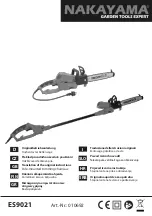
TROUBLESHOOTING
PROBLEM
SAW WILL NOT START
1. Saw not plugged in.
2. Fuse blown or circuit breaker tripped.
3. Cord damaged.
OVERLOAD KICKS OUT FREQUENTLY
1. Extension cord too light or too long.
2. Feeding stock too fast.
3. Blade in poor condition (dull, warped,
gummed).
4. Blade binding due to misaligned rip fence.
5. Blade binding due to warped wood.
6. Low house current.
DOES NOT MAKE ACCURATE 45
0
AND 90
0
RIP CUTS
1. Positive stop not adjusted properly.
2. Tilt angle pointer not set properly.
MATERIAL PINCHES BLADE WHEN RIPPING
1. Rip fence not aligned with blade.
2. Warped wood.
MATERIAL BINDS ON SPLITTER
1. Splitter not aligned correctly with blade kerf.
SAW MAKES UNSATISFACTORY CUTS
1. Dull blade.
2. Blade mounted backwards.
3. Gum or pitch on blade.
4. Incorrect blade for work being done.
5. Gum or pitch on table causing erratic feed.
BLADE DOES NOT COME UP TO SPEED
1. Extension cord too light or too long.
2. Low house current.
3. Motor not wired for correct voltage.
MACHINE VIBRATES EXCESSIVELY
1. Saw not mounted securely to cabinet stand.
2. Stand is on uneven floor.
3. Damaged saw blade.
4. Bad V-belt(s).
5. V-belt not tensioned properly.
6. Bent pulley.
7. Improper motor mounting.
8. Loose hardware.
BLADE DOES NOT RAISE OR TILT FREELY
1. Sawdust or dirt in raising or tilting
mechanisms.
SOLUTION
1. Plug in saw.
2. Replace fuse or reset circuit breaker.
3. Have cord replaced by a certified electrician.
1. Replace with adequate size cord.
2. Feed stock more slowly.
3. Clean or replace blade.
4. Check and adjust the rip fence. See rip fence manual.
5. Select another piece of wood.
6. Contact your electrical company.
1. Check blade with square and adjust positive stop.
2. Check blade with square and adjust pointer to zero.
1. Check and adjust rip fence.
2. Select another piece of wood.
1. Check and align splitter with blade kerf.
1. Replace blade.
2.Turn blade around.
3. Remove blade and clean with turpentine and steel wool.
4. Change the blade.
5. Clean the table with turpentine and steel wool.
1. Replace with adequate size cord.
2. Contact your electric company.
3. Refer to motor and /or nameplate.
1. Tighten all mounting hardware.
2. Reposition on flat level surface.
3. Replace blade.
4. Replace belt(s).
5. Adjust belt tension by moving motor and/or motor bracket.
6. Replace pulley.
7. Check and adjust motor mounting.
8. Tighten all nuts, bolts and set screws.
1. Brush or blow out loose dust or dirt.
PARTS DIAGRAM & PARTS LISTS
Refer to the Parts section of the King Canada web site for the most updated parts diagram and parts list.





























